September 18th, 2010 · No Comments
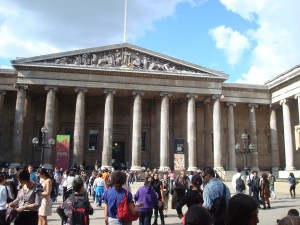
The museums of London seem to all fall around one dominant theme: imperialism. Seeing that this defined the British Empire for a majority of the last three centuries, it is no wonder that one can see its influence in each place one visits in London. Every museum either boasts the riches and plunders of the imperial era or makes some sort of comment on imperialism by what the curators chose and didn’t choose to include. As imperialism is, in my mind, the central idea around which all these museums exist, I’m going to take a look at each of the museums I have visited as reflections on the topic:
The British Museum: Many have already commented about the BM’s collection of artifacts and treasures from around the globe. It’s hard not to look at the mummies of ancient Egypt or the Elgin marbles without wondering just how exactly the BM got a hold of them. For its part, the museum seems to take delight in owning a collection that many would not consider rightfully theirs. On the “History of the World in 100 Objects,” I noted the quip the curator made about the “four languages” on the Rosetta Stone (as “Captured by the British Army” appears in English on the side of the artifact). While the BM could just ignore England’s imperial past, it seems to be content with making quips about where these objects came from. Essentially, the museum feels like a chance to show off the spoils of imperialism to rest of the world.

The Victoria and Albert Museum: This museum feels like a massive palace packed with valuables. In keeping with the British Museum, everything is thrown into areas based around vague “themes.” If you want to see jewelry, be prepared for a lot of rooms with a lot of randomly assorted riches. If you seek a certain historical artifact, you can probably find the right room based on the era and location of the piece, but after that you might have some problems as the rooms are randomly set up and gargantuan. Given the opulence of the collection, one cannot help but wonder how in the world the V&A wound up with all this stuff. The riches of imperialism are on full display at the V&A.
The Sir John Soane Museum: If the Victoria and Albert Museum feels like a massive palace packed with valuables obtained through imperialism, the Sir John Soane Museum IS a house packed with valuables obtained through imperialism. The place screams overkill, with walls of paintings that open up to more walls of paintings. I was particularly struck by the ivory chairs from India obtained during the eighteenth century: a very offsetting piece of the collection.
Natural History Museum: A few of us went through this museum after visiting the V&A, as the museum originated from the leftover collection at the V&A. While most of what one sees in the museum would not instantly recall British imperialism, some elements of the collection, like precious gems from South Africa, lead one to wonder just exactly how the museum got a hold of these pieces.
National Gallery: I really enjoyed this museum, but it is entirely Western European paintings. Given the Docklands Museum of London’s reference to the beauty of the arts in Africa before imperialism and slavery, why are none of these cultures, or those of the Middle East, represented?

National Portrait Gallery: I won’t go too much into this one, as several of my colleagues have already commented on the National Portrait Gallery’s imperialist nature. There is a stunning lack of racial or economic diversity in the collection, and I think a lot of that is a result of Britain’s imperialist past.
The Imperial War Museum: For a museum with the word “imperial” in the title, this museum actually had some of the least evidence of Britain’s imperial past of any of the places we visited. Only part of one wall was dedicated to all of the events surrounding the colonization of Africa, and I cannot recall any of the exhibits examining the struggles and fights for independence in any other former part of the British Empire. It is almost as if the curators wanted to sweep the entire history of British imperialism under the rug to focus on the glories of WWI and WWII. Based on the exhibits, one could easily come to conclusion that the Britain is embarrassed of its complete history. It was a cool museum, and I loved the section on British espionage (Who can’t love an exhibit that begins with James Bond clips?), but I found the museum incomplete because it ignored England’s imperial past.
The Cabinet War Rooms/Churchill Museum: My personal vote as the coolest museum in London, the Cabinet War Rooms show Britain near the end of the era of imperialism. Given the museum’s narrow focus, looking just at Churchill’s life and the struggle of the War Cabinet during the WWII Blitz, there was not much focus given to imperialism. One section of the Churchill Museum commented on the prime minister’s stance, early in his political career, in opposition to Indian independence. The part of the exhibit took a very apologetic tone, acknowledging Churchill’s mistake in taking such a position. Considering this museum is run in conjunction with the Imperial Museum, this part of the exhibit may provide an insight into the mind of the curators at that museum. Clearly, there is some sense of remorse on the part of the curators, evidenced by the Churchill Museum, for the British Empire’s actions, which could explain the lack of information about such events in the Imperial War Museum. Perhaps the curators are too ashamed to even broach the subject of British Imperialism.
Based on my observations, every museum I’ve seen in London is either indebted to imperialism due its bountiful collection of artifacts, or it tries to comment on the British Empire’s imperial past, typically by covering it up. Fifty years after the fall of imperialism, which is not that long ago, we still see its effects on the city of London.
Tags: 2010 Andrew
September 14th, 2010 · 3 Comments
We’ve already talked about the elitism that we’ve seen in museums such as the National Portrait Gallery and the National Gallery, and I’m sure that everyone has at least a passing familiarity with the debate over the Elgin Marbles. (If not, Stephenie wrote a small book about it a few days ago, so just keep scrolling down the page.) I don’t want to beat the imperialism theme over the head too much, so I’ll try to take a different angle here. What has struck me about so many of the museums that we’ve visited has been the vast collections of stuff housed within their walls. Isn’t this the point of musuems? you might ask. Well, yes. But I feel like the size of the collections and the way that they are displayed here just screams “materialism” more loudly than any museum that I’ve visited previously.
Apart from the British Museum, the Victoria and Albert Museum is the best example of this. The array of exhibits in this museum is incredible–everything from fashion to theatre, jewelry, micromosaics, sculpture, medieval art, and every silver dish ever manufactured in the British Empire. Wandering through (the floor plan made absolutely no sense to me, so I just walked around), my eyes started to glaze over because of the sheer number of artifacts displayed. In the silver rooms, for instance, there were cases packed so tightly with pieces that there was not enough room for display cards; interested viewers had to pick up a card that was chained to the outside of the case. And underneath all of these cases, which took up a pretty substantial area, were drawers full of more pieces that didn’t fit in the displays. It was insane. The V&A had some amazing pieces, but the opulence and materialism on display there were astounding.
Although some of the other museums that I visited were much smaller and were actually house museums, I noticed this same glorification of materialism. The Sir John Soane Museum is a wonderfully eccentric home that Soane, a nineteenth-century architect, designed specifically to hold his collection of artifacts and his “cabinet of curiosities.” It’s really neat to walk through and see all of the peices that he has hiding in the nooks and crannies of his home (one room has extendable walls that fold out from the permanent walls. There are currently sketches by J.M.W. Turner that are displayed on these hidden walls). His collection includes several pieces of Greek and Roman statues, wonderful works of art by Hogarth and Canaletto, and even an Egyptian sarcophagus. But again, I got the sense that there were just so many things packed into such a small space. And I had to wonder, like Stephenie, how he came by all of these treasures and why he needed a room full of Roman busts. It seemed as though he had collected all of these things simply because he could. Thankfully he had the foresight to turn his home into a museum so that his collection would be accessible to the public to come and learn from it, but the thought still lingered. The Wallace Collection left a similar feeling, although a large portion of the collection housed there comes from other parts of Europe.
I firmly believe that these huge, opulent collections are only possible because of Britain’s imperial past. They had access to so much of the world, and they had the power and the weapons to take artifacts from all of these places (even if the Elgin Marbles were supposedly sold legally). As the strongest nation of the nineteenth century, Britain was able to amass all of the silver found in the Victoria and Albert Museum, and all of the pieces of sculpture housed in the Soane. The money was there and the artifacts were ripe for the taking, so materialism (and I think fascination with exotic cultures, especially with the Orient) naturally followed. I’m not trying to say that this is right or wrong, and Americans as a whole definitely value the consumer and material wealth. It’s just what has really struck me from the museums that I’ve visited.
Tags: 2010 Holly · Museums
September 11th, 2010 · 2 Comments
London’s diverse museums all have an element of British imperialism. The three which best show this are the Wallace Collection, the Sir John Soane Museum, and the British Museum. Yet, each takes a different approach to them: the British Museum is the standard artefact with didactic label, the Soane shows the spoils of an imperialistic age in the wonderful cabinet of curiosities method, and the Wallace Collection arranges its collection as a wonderful combination of the two.
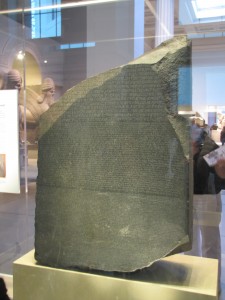
The Rosetta Stone, which has been a centerpiece of the Egyptian repatriation demands.
We’ll start with the British Museum. Perhaps the most controversial collection because of the Elgin Marbles, most of the collection could probably be at the center of a repatriation argument if a government decided to challenge the museum. Instead of noticing that the museum was a shrine to British imperialism, my first thoughts (once I pulled myself away from the medieval galleries) were about the museum’s role in the ongoing battle over countries reclaiming their artefacts. My general beliefs on repatriation are simple: the works belong wherever they are going to get the best care, which, unfortunately for the vast majority of the ancient objects, is not in their countries of origin. For example, there is no way that Egypt can assume responsibility for its antiquities; the ones there are deteriorating alarmingly. While Hawass has done a good deal for Egyptian antiquities, their facilities still are nowhere near those of the British Museum’s facilities. Furthermore, shouldn’t objects that have influenced the whole of history be where the most people have access to them? Surely that is here, in London, not in Cairo?

One of the Elgin Marbles
Unfortunately, that argument is no longer valid for the Elgin Marbles (although, while not as an unpredictable environment as Egypt, Greece does have its problems which could threaten the marbles). Greece has a new acropolis museum that is a perfectly suitable house for the marbles. So, why do I still believe they belong in London? Aside from the whole no-objects-can-leave-England-law and the incredible galleries they are currently housed in, there a couple of reasons. Firstly, their provenance, unlike that of the Italian krater the Met repatriated to Italy, shows them to have been purchased legally versus outrightly stolen. We may not agree with the way they were handled in the 19th century, but because we have a different understanding of the proper way artworks should be sold/purchased does not mean we can go back and make amends with everything. The world’s great museums would be emptied. Secondly, where they are now, they are more accessible. If Greece didn’t have almost as many as the BM, I’m sure everyone would feel differently about the issue. (Well, except for Greece, which would still demand them all, even in the BM only had one.) Because repatriation has become such an important issue, I do believe that even if English law did not forbid it, the marbles would never go back to Greece because once the BM accepts Greece’s arguments, the watershed for repatriation will be open and museums will be scrambling to quadruple check their works’ provenances, possibly wasting valuable resources.
It was only after my second visit to the British Museum that I wondered about some of the works’ provenances. However, from the moment I stepped into the Sir John Soane, all I wanted to do was demand to see some of the provenances of various works, as well as pick up the objects to examine them and the way that they were removed from their original locations. I think part of the reason that it took a second visit to the BM to question it was as one of the leading museums in the world, it has more authority as the stellar, but smaller, Soane. The traditional layout of the BM commands respect, whereas the Soane is easy to mistake for a pile of junk haphazardly arranged. Except, it is the exact opposite: the Soane has incredible pieces. (I could have died of joy looking at the random Gothic bits.) Because of the arrangement- a life size cabinet of curiosities- it is easy to forget that all of the works can point to the achievements of Soane and his time, noticeably imperialism. When walking through, one’s mind is trying to take in everything and is not assisted by didactics, the larger picture is sometimes lost, unlike at the BM, where the layout and didactics remind you almost constantly that while the museum is “British”, the majority of the collection is not. Furthermore, the Soane’s arrangement allows one to feel closer to the objects. Indeed, it is easy to get away with a close examination of the work on the wall and touching them. In the BM, the viewer is often annoyingly separated from the work by class or a rope barrier.
If the BM is arguably the most controversial museum because of its collection, then the Soane is the most overlooked for controversy. Lots of the works were supposedly removed from crumbling sites. Were the sites crumbling before or after the works were removed? Did the dealers have explicit permission? These questions are largely overlooked; in fact, lots of information is overlooked, which adds to the feel of a cabinet of curiosity.
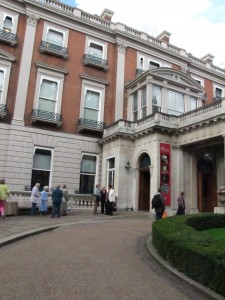
The Wallace Collection
The Wallace Collection is like the Soane in that it started as one cohesive collection and has grown, as well as that it shows the way the works were staged by their original collector. However, unlike at the Soane, the Wallace Collection does an amazing job of showing lots of works in a way that is not as overwhelming. The collection is mostly housed in period rooms, which add to the atmosphere of the museum, greatly enhancing the works. Instead of wondering about whether the objects should be repatriated, the collection sets up the works in such a way that the viewer is not distracted by theoretical questions on museum practices. (Unless said viewer gets bored of Rococo and armour.) Furthermore, the collection focuses on European art, which focuses it a bit more than the other two museums. If anyone is interested in armour, the Wallace’s collection is superb and world-renowned. Instead of wandering around the museum pointing to works I wanted to examine for causes to repatriate, I wandered the Wallace wondering why certain works were hung together and why anyone would want rooms upon rooms of Rococo art, much less why I was wondering around them when there were three outstanding armouries downstairs that were calling me.
Yet, part of me wonders if Britain didn’t have it’s imperial past, would I be able to see this quality of art and artefacts. If I were able to, would I wonder about the provenance and history of each work as much?
Tags: 2010 Stephenie · Museums
September 19th, 2009 · 4 Comments
The Sir John Soane Museum was the last thing I was able to squeeze in before leaving for Norwich. The museum was interesting, however I do not think it was very educational. It was essentially just peering in on Sir John’s house and his collection, but there were very few signs telling the museumgoer about the relics that were scattered around the house. The architecture was amazing as was the collection, and like most of my classmates I would love to live there if it were not so narrow in parts of the house. However, I do not see its relevance to the course. Why Professor Qualls did you choose to throw it onto our list? I am having a hard time saying anything about the museum because I do not see how it fits into the theme for this class. Honestly, I have learned more from the museum’s website than I did in the actual museum. The website has the entire collection on it with blurbs about the history of each piece. However, unlike most other museums the website does not display a mission statement or any of the museums goals. I believe that every museum should have a mission statement. This makes helps the curators organize exhibits, artifacts, and information panels. With out a strong goal relics are just crammed together, like in the V&A, or there is very minimal educational material, like the Sir John Soane Museum.
I never thought of myself as particularly interested in museum studies, but after visiting all these museums I can see what foundations need to be there for a museum to work. Out of all the museums we visited I feel that the Docklands museum did the best job in presenting and preserving its artifacts and its history while doing a great job educating its visitors. The museum has a clear goal: to educate the public on the history of the docklands. It also has a clear pathway that one can choose to fallow at their own pace, while the British museum had no path way and tended to get very congested at various parts of the exhibits. These large crowds of people greatly affect the safety of the artifacts that the museum is trying to preserve. People should not be allowed to touch, feel, hug, and take pictures of ancient Egyptian sculptures. These crowds are also not good for the safety and education of the museumgoer. Old women or men should not have to be pushed around to have a glance at the mommies, and one should be able to easily see and read the information panels next to the relics if they choose to do so. At least The Sir John Soane museum limited the number of people in the museum at one time in order to protect the artifacts and the people (as it would probably be a fire hazard for too many people to crowd into that building). Maybe the British museum can look to the Soane museum for advice and limit the number of people in the mummy room at one time and increase security. While perhaps the Sir John Soane museum can fallow the British museum’s model and provide more information on the artifacts within the house.
Tags: Rebecca
September 15th, 2009 · No Comments
-
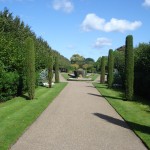
-
Regents Park
-
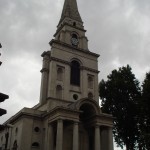
-
Christ’s Church
-
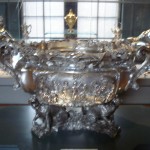
-
The Silver Exhibit in the V&A
-

-
Having a Good Time at the Fitzroy
Like many of my classmates I decided it would be worthwhile to summarize all of my discoveries this month in London. During this post I will focus on six main themes found within London: Parks, Churches, Pubs, Other Religious Institutions, Theatre and Museums.
Parks
Each park that I visited had its own distinct characteristics that separated it from any other. Green Park was the first I visited and after perusing a few others, I realized there was nothing that exciting about it. Located right across from Buckingham Palace, Green Park certainly provides a good place to go and take a break from the busy atmosphere of the area. Besides this however there is not much going on and I would recommend that potential park goers walk the extra distance over to St. James Park.
In addition to the large number of waterfowl heckling people for food which offers consistent entertainment St. James offers some picturesque flower beds throughout and various monuments along the way. It has the relaxing atmosphere of Green Park with a bit more excitement sprinkled in.
Regents Park offers a completely different feel from Green or St. James. Located in a separate area of London, Regents Park has a history of being used by a higher end crowd. I could tell this immediately from the feel of the park. The decorative shrubbery and elegant architecture throughout gave me a feeling that Regents is not as well used as other parks.
Since I was one of the members of the Parks group that gave a walking tour of Hyde Park and Kensington Gardens I could go into a lot more detail about these two green spaces but I will choose not to in an effort to be concise. In summary Hyde Park is the largest green space in London and is often used for larger events such as concerts, festivals etc. It also contains a large number of monuments throughout including the 7/7 memorial and the Diana Memorial Fountain. Kensington Gardens is home to a variety of key monuments but is not as well trodden as Hyde. Overall it makes for a quieter atmosphere, more conducive fo reading or “snogging”.
Regents Park were my two favorite green spaces in London. Regents, is both beautiful, and extremely large and I continually felt the need to go back and explore. Kensington Gardens appealed to me in that it was quainter than Hyde Park but contained a like amount of history and monuments throughout. Although I would be content spending a length of time in any London green space Regents and Kensington would be my top choices.
Theatre
Overall I enjoyed going to the theatre on so many occasions. What better place to do so than in London after all? Here I will discuss my favorite performances and theatre venues.
All in all I enjoyed all but two of the performances we saw. The two Shakespeare productions at The Globe Theatre were fantastic. Although I did not particularly enjoy reading Troilus and Cressida it made a huge difference to be there so close to the actors. The fantastic drum chorus at the end really sealed the deal. As You Like It was probably my favorite show I saw here in London. Although it is one of Shakespeare’s simpler plays the actors really made it jump off the page. Being down it the pit was fantastic because of all the ad-libbing and constant interaction with the crowd. I even felt traces of Touchstone’s saliva on my arm at one point.
The other Shakespeare performance I saw, All’s Well That Ends Well, was lackluster. Although the Olivier was my favorite performing venue (this is what an auditorium style theatre should be like…why can’t Dickinson have something like this?) the play itself was odd and ended on an abrupt and odd note.
The other play we saw at the National Theatre, The Pitmen Painters, was fantastic. Although I was dozing a bit because of the Benadryl I took right before the show, the actors kept my attention and I appreciated that the play was based off of a true story.
Easily the oddest play we saw was Arcadia. An extremely intelligent performance the play juxtaposed two different periods in time and created a singular storyline in which the plot was based. Overall it was an entertaining performance that made me think early and often.
Finally there was Blood Brothers. The lone musical I saw produced feelings of disbelief, anguish and held back laughter. The ridiculous 80’s sound track and creepy narrator just didn’t do it for me. I think it’s safe to say that I was not the only one from Humanities 309 who was a bit surprised to see just about everyone in the audience give it a standing ovation.
I had a very positive experience with the theatre here. I would go back to the globe again and again. I loved being that close to the action. I would also enjoy seeing another show in the Olivier. There really is so much to choose from here. It’s simply a matter of figuring out your tastes and saving your money so you can see a lot of performances.
Churches
From Westminster Abbey to St. Paul’s Cathedral we saw most of the major churches/cathedrals during our month in London. St. Paul’s was easily my favorite. From the fantastic crypt to the hundreds of stairs up to the tower it had so much to offer in the way of history and mystique. Westminster Abbey fascinated me primarily because of all the literary figures that had been buried inside as well as the room that was dedicated to “The Order of the Bath”. Other churches that I really enjoyed taking a look at were: “St. Martin in the Fields” which sits just outside Trafalgar Square and Nicholas Hawkesmoore’s “Christ’s Church” which is located in very close proximity to Brick Lane.
Other Religious Institutions
Overall the Sikh Gurdwara was my favorite place that we visited. I appreciated the simplicity of the religious doctrine as well as the conviction and honesty with which our tour guide, Mr. Singh spoke. The morning was capped off with a fantastic sit down meal together in which everyone was served the same food and drink.
I had different feelings about the Hindu Mandir. It was clear to me from the very beginning that the Hindu religion is not nearly as modest as Sikhism nor are they trying to be. From the extremely decorative prayer room, to the museum located right in the center of the Mandir I never felt particularly comfortable inside.
The only religious institution I wish we had gotten a chance to visit is a Mosque. I had been to one many years ago but I did not remember a whole lot from my experience. I wonder how much more lively the East End, and all parts of London would be if Ramadan were not taking place during our time here.
Museums
I could go on and on about museums so I will attempt to stay as concise as possible.
The British Museum was massive, convenient since it was so close to the Arran House but a little one dimensional at times. One of my favorite exhibits at the British Museum was a special exhibit on Living and Dying that drew information from all different time periods and cultures.
The National Gallery was fantastic. Although I have a hard time appreciating some visual art the gallery kept my attention for a number of hours. Seeing so many famous works of art was phenomenal.
The Tate Modern was my least favorite museum here. Although I am trying I have a hard time understanding modern art. After about 45 minutes in this museum it ended up being too much for me.
The Cabinet War Rooms/Churchill Museum were two of my favorites. The realization that I was standing in one of the most important places in World War II history was unbelievable. The War Rooms felt so authentic. I really felt as though I had been taken back in time to the 1940’s while inside.
The Victoria and Albert was easily my favorite museum in London. There was so much variety inside and so much to see. I could have easily spent a few days inside. Two of my favorite exhibits were the silver and jewelry exhibits. I’m not sure what this says about me as a person but I found it unbelievable that individuals could even own such treasures. I also enjoyed the laid back atmosphere of the V&A staff. At most of the other museums I visited I felt like I was doing them a disservice simply by being there. Although I understand that taking pictures of an object in a museum doesn’t do it justice I like to be able to have the option of doing so.
The Sir John Soane museum interested me but it wasn’t really my cup of tea in the end. It also had a stuffy atmosphere to it that I didn’t really appreciate.
One thing I can draw from my experience at museums here is that each and every one has something that distinguishes it. With so many museums I thought that it would be impossible to avoid some overlap but I never really felt that. Cheers to London and its museums.
Pubs
Finally we have pubs. What would London be without it’s public houses? In some cases pubs are the true museums of London, designating what an area was like in the past and what type of clientele it attracted. During my month here I had a chance to visit a few pubs and get a general sense of what some possible differences could be. It is clear to me that each pub brings something different and unique to the table. The Marlborough Arms was convenient being so close to the Arran House and was a great place to enjoy a pint over a meal with friends. The Court was conducive to socializing in a different way. The music was louder, the people louder and the drinks cheaper. Other places I visited offered other things that made them stand out as well. One thing that i’ve learned about pubs is that it’s hard for one to please everyone. Since everyone has different tastes and desires when it comes to pubs you are better off going to one with a small cohesive group.
To conclude this novel I would just like to say that I think we saw a lot of different faces of London this month. I realize there is much more to see here but between walking tours throughout the city, trips to major monuments and museums and individual exploration I have learned a ton about London, it’s history and where it is going. I look forward to more London explorations in the future but for now, ON TO NORWICH!
Tags: Churches and Cathedrals · Henry · Pubs · Theatre
September 14th, 2009 · No Comments
After spending a month in London and visiting a plethora of museums, they all are beginning to blur together in my mind. I have an easier time remembering specific pieces included in the museums that I loved rather than the overall museum itself, but I’ll try to relay my general sentiments of my final two destinations, the Sir John Soane and the Victoria and Albert Museums.
I felt that the Sir John Soane Museum was fascinating, but was distracted by how much was packed into such a small space. I wasn’t able to fully enjoy what I was looking at simply because I got a bit claustrophobic. On the flip side, though, it certainly was impressive how much was packed into the equivalent of three townhouses. One of my favorite aspects was the collection of clocks included in the house, because it reminded me of our trip to Greenwich and the importance of early timepieces. His particular collection stuck me because it really showed how clocks were once a symbol of status, specifically that which was made for Christopher Wren by Queen Anne.
Although the Sir John Soane Museum had interesting artifacts and art, I much preferred the Victoria and Albert Museum. My favorite section was the sculptures portion on the ground floor, and I spent a great deal of time exploring there. I enjoyed reading the captions to each, for example, a plaque under a bust of Albert Einstein stated that he was a culmination of “the humane, the humorous, and the profound.” Another statue, a monument to one Emily Georgiana, moved me in saying “I who dreamed wildly and madly/am happy to die.” The writing on that statue seemed simultaneously inspiring and sad, and I’ve thought of that quote often since reading it for the first time. My favorite actual work was a bronze piece created to hang above a fireplace depicting a nude man and woman entwined while being watched by a shocked and disgusted crowd. Made by Charles Sargeant, “Scandal” was interesting to me because it showed not only a couple in love (as many works do) but also the rarely shown negative reaction of the surrounding community. Lovers in art are so often isolated, so seeing a different perspective within the work was certainly interesting.
To summarize my previous blog entries regarding museums, I was unaffected by the British Museum, disliked the Tate Modern, moderately enjoyed the Cabinet War Rooms and Churchill Museum, and loved both the National Gallery and the Victoria and Albert museum.
Tags: Amy
September 12th, 2009 · No Comments
During the past few days I have been trying to tie up a few loose ends before preparing for the big presentation Anya, Audrey, Maddie, Megan and I are putting on in front of the Alumni next Tuesday night while simultaneously packing for UEA. This morning I decided to visit the Sir John Soane Museum. Going into the visit I had heard very mixed feelings about it. Some of my classmates loved it while others did not at all.
One thing that distinguishes the Sir John Soane museum from other prominent London museums is that it is only open from 10 a.m. to 5 p.m. 6 days a week so people only have a slim window of time to visit. This morning I arrived in front of the museum five minutes before ten and there was already a queue of people lined up in front of me anxiously waiting to get in. Looking at the outside of 13 Lincoln’s Inn Fields nothing about the building struck me as spectacular. Once I stepped inside however this changed dramatically. The Sir John Soane museum essentially showcases all of Sir John’s home which contains, to put it colloquially, a whole lot o’ stuff. Walking through I wondered where he obtained many of the objects he had sitting throughout the building.
After walking through Sir John’s library and his two studies I made my way into his picture room. Here I was utterly amazed to see a multitude of works by William Hogarth, most prominently a series of paintings entitled ‘A Rake’s Progress‘ which Hogarth is best known for. ‘A Rakes Progress’ depicts the life of a man named Tom Rakewell who abandons the mother of his baby, makes poor choices and spirals his life out of control before going mad. Hogarth elegantly displays this transformation on eight works of art, all of which Sir John had hanging on the wall of his picture room.
The other part of the Soane museum that amazed me was the crypt. Down below Soane had a large variety of sculptures and other fascinating objects. Perhaps the most intriguing was the Sepulchral Chamber which featured the sarcophagus of King Seti I who ruled Egypt from 1303-1290 BC. Soane purchased the Sarcophagus from Giovanni Belzoni in 1824 outbidding the British museum and adding just another piece of history to his already vastly historical collection.
After completing my tour of Sir John’s humble abode I was struck by the sheer amount of objects Soane had in his home. In certain parts of the house there was almost no room to move around because there were so many things hanging on the walls. I can’t imagine anyone today keeping all of that fortune sitting around in their home. It would be stolen in a heartbeat. I also can’t imagine obtaining the sheer number of sculptures, paintings and trinkets that Soane had lying within.
——————————————-
On Thursday night our class saw a performance of the Pitmen Painters at the National Theatre. Based off of a true story the play focuses on the life of four miners and how their lives are transformed through their appreciation of art. What’s significant about the Pitmen Painters is that they have next to no material possessions, are some of the most simple minded fellows on the planet and are unable to think in the abstract. The catch is that they are content with their lives for the most part. They don’t need much else.
It’s funny how everyone’s definition of wealth is relative. When Oliver, one of the Pitmen Painters, started to appreciate art a whole new world was opened up to him and his life felt that much more expansive. The Pitmen Painters had a chance to go to London and upon coming back they saw that there was more out there than their little world in the mines. I wonder what Sir John Soane would do if the reverse happened and he had to spend a some time in the life of a Pitmen Painter? Somehow I think Soane would be a little bit thrown off. When you have the ability to get anything you want whenever you want it makes it hard to take a step back and take life as it comes to you.
But is it?
To connect this to William Shakespeare’s As You Like It (which we saw at the globe theatre on Thursday) i’d like to point out the example of Duke Senior who is usurped from his thrown and sent to the countryside where he forms his own court. Duke Senior is immediately thrown from a life of wealth and power into one of simplicity yet he seems to react completely unfazed. As we observe his actions throughout the play it actually seems that he enjoys the simplicity of country life a bit more. He welcomes in Orlando and Adam when they have nearly perished from starvation even though he does not have the unlimited supply of food to offer that he would have had as Duke.
————————————–
So…drawing from these three examples found right here in London I am about to get deeply philosophical. What is it we desire as students, with our Dickinson education that costs us thousands of dollars? Do we wish to live a life where material possessions run our lives and collecting antiques becomes simply a hobby? Or do we wish to live a life of simplicity where all that matters is what is immediately around us? I’m guessing most people will fall in the middle somewhere. We have made the choice to take this year to learn and be immersed in another culture. Even though the majority of people in England speak the same language as us we have already realized that there are vast cultural differences here beyond our wildest dreams. At the end of this trip we will have expanded our horizons and seen things that we’ve never had the opportunity to see before. That is a given. The key is what we take from these experiences. If there’s one thing i’ve learned from London so far it’s that things can change in a heartbeat here. It may be something as simple the weather, or something as vast as a new ethnic community moving into the east end. I hate to get cliche here but I think we can view London as a metaphor for life. There may be times where we find ourselves in Duke Senior’s situation where everything we thought was ours is completely taken away and we’re forced to adapt. Perhaps we’ll be faced with a life changing revelation like the Pitmen Painters when they discover art? Maybe we’ll even have the chance to live like Sir John Soane? All I know is that I am going to take in all I can of London in these next four days. Who knows what else can be found?
Tags: Henry · Museums · Theatre
September 11th, 2009 · 1 Comment
The beauty hit us.
Like waves against
the stones of the shore upon which the fiddler, the architect, played.
It gave way to
whimsical
terror
and with each turn
of a page or corner,
we discovered that
only a new anguished horror awaited us.
Variably, precision melted,
moaned away
into l e g a t o s l u r s
of
terse
vibrations
and
amorphous design. The crashing dissonance hit us,
poured over us and into our eyes and ears,
unwinding the tendrils
of muscle which control
perception and jamming
the cogs
which regulate a finely-tuned, mechanical reality.
Amidst the breakdown stood a man. He stood
alone, crazed and removed
and moving
erratically, creating
buildings and music and life in the midst of chaos.
This sound, this place, is chaos.
Can sound not be
[a place]
? We were told that art is. How can you argue that
this is not art?
Tags: Anya · Museums
September 11th, 2009 · 1 Comment
Though a far cry from the traditional set up of a museum as everything is held in a man’s house, the Sir John Soane Museum showcases aspects of the British identity quite well. In fact, the museum’s success in its portrayal of the British identity might be attributed to the fact that it is in Sir John Soane’s house. The placement demands that attention be paid to the man and the object rather than just the objects on display. The objects he collected are incredible- beautiful, intricate, and plentiful. Still, one would find difficulty leaving the house without considering how the objects, the man, and Britain all tie together.
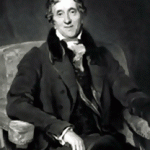
Sir John Soane
Sir John Soane, an architect most famous for his work on the exterior of the Bank of England, understood the importance of inheritance in the British social set up. The son of a mason, he was in good company for improving his skills in the building trade. If he was content with being just another mason or even just another architect though, I wouldn’t have anything to write about in this post; that is, his collection, his museum, his legacy, his influence- none of this would be possible. His social stature needed to improve. Sir John Sloane lived and worked during the Georgian era, a time known as the “Age of Aristocracy” in which the British aristocracy enjoyed a level of prominence in society. While wars of independence and revolutions for social equality raged in other lands, the English social scene continued to favor the upper classes that the others were rebelling against. Understanding the importance that his social stature had in such a society, Sir John Soane married into money in 1784. This marriage gave him the social status that enabled him to reach a more elite class of customers and, as a result, be involved with more impressive and monumental projects. His talent alone was noteworthy. Before he married, he had already won many awards in architecture, traveled to Italy to perfect his craft, and had began compiling images for a publication that would come out in 1788. I don’t mean to belittle his talent at all. Still, it wasn’t until after his marriage that he started to design more major projects including his most famous work on the Bank of England. There has to be a link between the wealth and stature he acquired in his marriage and the timing of his more famous works. Yes, he was good but you have to be great to be sought after to work on such large-scale projects as the Bank of England. Why was he sought after for such projects? I would argue that the answer lies in the fact that people of a certain social circle knew his name because of his social status in London.
Soane’s displaying his possessions to the public can be seen then as a key portrayal of the British identity. He was able to collect all of these remarkable objects because he was wealthy and influential enough to even be considered as a possible owner in the first place. His social climbing, in my opinion, played a major part in getting him to that status. Let’s remember that Sir John Soane didn’t just display these impressive objects in a building (something he could have easily crafted given his profession). He displayed everything in his house and, in doing so, put his house and himself on display as well. His life became part of the exhibit. So truly his life must be considered as much as any of the objects in the museum upon reflection. The statues were beautiful but does anyone need that many? Short answer: no. Sir John Soane seemed to think differently though. For this reason, his seems to have an understanding of the importance of showing off one’s social status in the English society. He needed people to understand just how well off he was. What better way to accomplish such a thing than to display impressive object after impressive object in the context of your home ?
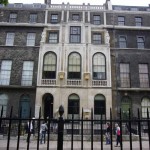
Outside of Sir John Soane's home
Interestingly enough, the museum has been and continues to be free of charge to the public as was declared by Sir John Soane the way it should be. This fare gives every person the same opportunity to visit the museum as the next. Was this a way in which to thwart the social fixtures that seemed to consume his society? Or was it a way to show off on the most massive scale possible? I’m not sure. But this college student certainly appreciated the fee. But no matter what the cost was to get into the museum, I think its impossible to only call it that. It’s more than a museum. It’s a portrayal of a man’s life and the society he tried so hard to impress.
Tags: Audrey · Museums
September 8th, 2009 · 1 Comment

Jack Sturges (American author and photographer) once said that “The world is shrinking as we see more and more of it in the media, and the more we see of the world, the smaller we are, the more aware we are of how insignificant any one of us is.” This is how I felt today at The Sir John Soane’s Museum, as if the world had shrunk into one house (a work of art) and I was there, insignificant.
I was surprised to arrive at the museum and realize that it used to be someone’s home, self constructed and designed. While waiting in line to enter I attempted to make friends with the doorman, and so I asked him to tell me a little bit about Sir John, who he was and what the museum was about. He responded by saying: “Well why are you here then? Why did you come to a museum that you knew nothing of, you should have done your research.” Him and I were off to a bad start. I expected him to enthusiastically respond, after all, I knew the basics and thought he could have shared a few things about the museum I didn’t know. I forgave him for making me feel stupid at that moment, but I guess he had a good point, I should have done my research. He did tell me about the importance of sunlight to Sir John and how he designed the house to have as much sunlight as possible entering in every room; I was now on the look out for the infamous windows.
The house was lit up with sunlight. Today was a sunny day and I was able to appreciate the house’s illuminates passageways and sculptures in the various rooms. His collection of artwork, as well as sculptures and treasures was breath taking. For someone to design such a marvelous home, and to spend their life collecting such amazing works is truly admirable. He had a piece of the world in different corners of his home and in any given room/space one can experience Egypt, Rome, Britain and even the transgression of time through paintings or within the pages of Soane’s 6,857 books.
In one of the rooms filled with paintings, one of the museum’s curators opened up the wall-sized doors where suddenly more paintings became visible to our eyes. There, were the paintings of buildings Sir John had designed, for he was a prominent architect, including sketches of the house itself and a statue of a women (whose name I cannot recall). Hidden treasures.
To be inspired to build such a home, as well as to collect such magnificent and priceless pieces of art is the kind of inspiration I seek. The one that goes beyond boundaries to further personal growth while engaging the outside world. Although Sir John Soane lived from 1753 to 1837 his life, his collections and his home will live on as an example to the rest of us of a rich life. So that one day we can rest knowing that we have completed our lives significantly.
Tags: Flow













